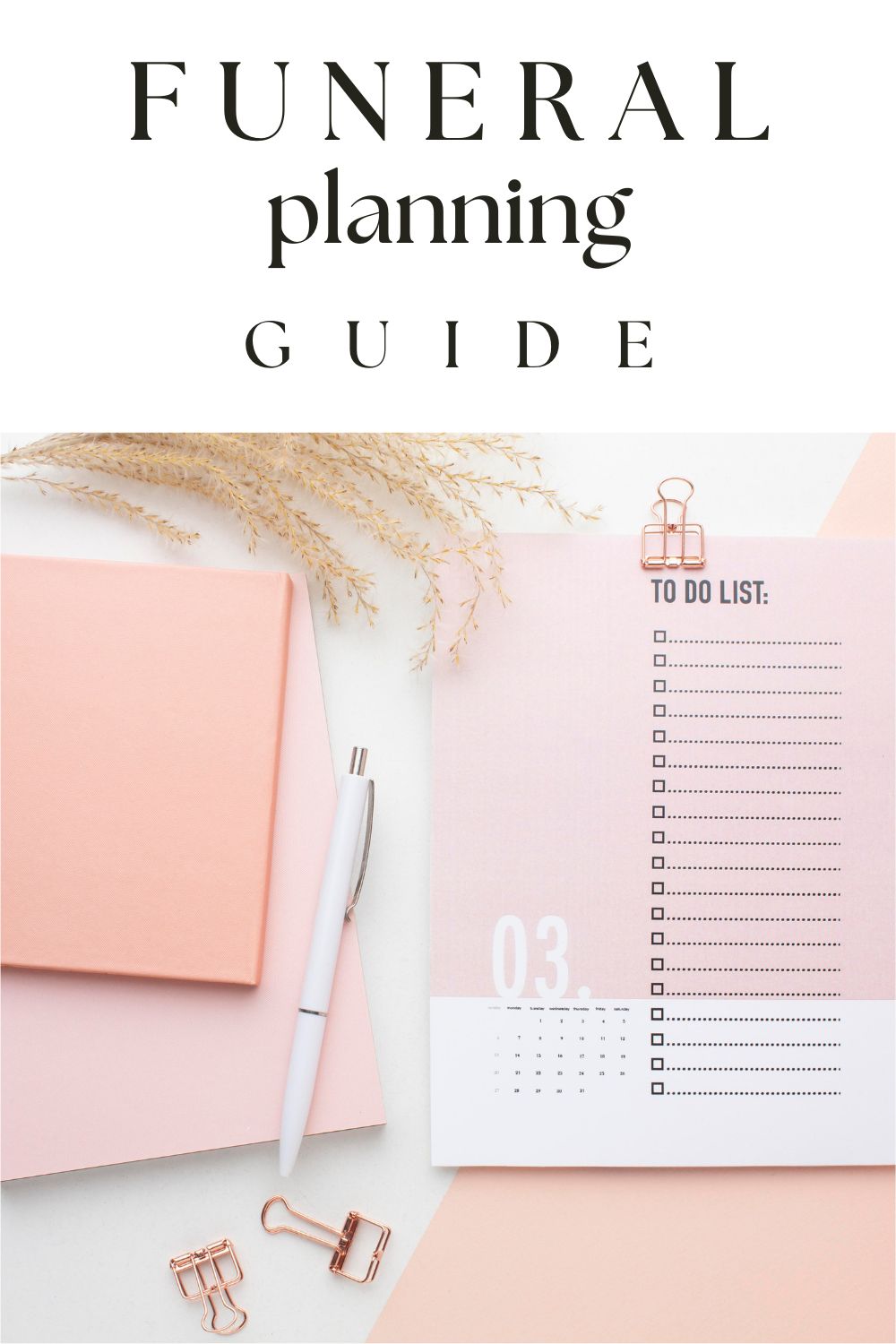We may earn money or products from the companies mentioned in this post. As an Amazon Associate I earn from qualifying purchases. Disclosure of Material Connection: Some of the links in this post may be "affiliate links." This means if you click on the link and purchase an item, I will receive an affiliate commission.
Facing the loss of a loved one is one of life’s most challenging experiences. During this difficult time, understanding how to navigate funeral planning can provide structure and comfort when it’s needed most. This comprehensive funeral planning guide walks you through every aspect of funeral planning—from the initial arrangements following a death to creating lasting memorials that honor your loved one’s legacy.
The Complete Funeral Planning Guide: From Arrangements to Memorialization
Why Advance Planning Matters
Many people are now choosing to plan their funerals in advance. Pre-planning offers several significant benefits:
- It relieves your loved ones of making difficult decisions during a time of grief
- It ensures your personal wishes are honored
- It provides an opportunity to make financial arrangements, potentially reducing the financial burden on your family
- It gives you time to consider options thoughtfully rather than making rushed decisions
Whether you’re planning for yourself in advance or making arrangements for a loved one who has passed, understanding the fundamental elements of funeral planning is essential.
Key Decisions in Funeral Planning
The funeral planning process involves several critical decisions:
- Type of disposition: Burial, cremation, or alternative methods
- Type of service: Traditional funeral, memorial service, celebration of life, or direct disposition
- Location of services: Funeral home, place of worship, cemetery, or other meaningful location
- Personalization elements: How to make the service reflect the unique life of the deceased
- Financial considerations: Understanding costs and payment options
Each of these decisions involves multiple considerations and options, which we’ll explore throughout this guide.
Initial Steps After a Death Occurs
The hours and days immediately following a death require several important actions. Understanding what to do can help you navigate this difficult time with greater confidence.
Immediate Actions
When a death occurs, there are several immediate steps to take:
- If the death occurs at home: Call the appropriate authorities based on circumstances (doctor, hospice provider, or 911)
- If the death occurs in a hospital or care facility: Staff will guide you through initial procedures
- Contact a funeral home: They can help with transportation of the deceased and begin the arrangement process
- Obtain the death certificate: The funeral director typically assists with this process
- Notify close family members and friends: Consider designating someone to help with notifications
Legal Requirements and Documentation
Several legal requirements must be addressed following a death:
- Death certificate: Multiple certified copies are typically needed for financial institutions, insurance claims, and property transfers
- Permits: Depending on your location, permits may be required for transportation, cremation, or burial
- Obituary information: Gathering biographical information for announcements
- Insurance policies: Locating policies and beginning the claims process
- Will and estate documents: Contacting the executor and/or attorney
Working with a funeral director can simplify many of these processes, as they’re familiar with local requirements and can guide you through the necessary paperwork.
Choosing the Right Funeral Service Provider
Selecting a funeral service provider is one of the most important decisions in the funeral planning process. The right provider will guide you through arrangements with compassion, transparency, and professionalism.
Types of Funeral Service Providers
Several types of providers offer funeral services:
- Full-service funeral homes: Offer comprehensive services including preparation, visitation, services, and transportation
- Cremation societies: Specialize in cremation services, often at lower costs than full-service funeral homes
- Green burial providers: Focus on environmentally friendly burial options
- Direct disposition providers: Offer simple cremation or burial without additional services
Questions to Ask When Selecting a Provider
When evaluating potential funeral service providers, consider asking:
- Are they licensed and in good standing with regulatory authorities?
- Do they provide clear, itemized price information?
- What services are included in their packages?
- Can they accommodate your specific cultural, religious, or personal preferences?
- What are their facilities like, and can they handle the size of service you’re planning?
- Do they have experience with any special requests you might have?
The Federal Trade Commission’s Funeral Rule requires funeral homes to provide itemized price information, allowing you to compare costs and select only the services you want.
Types of Funeral Services
Funeral services can take many forms, each offering different ways to honor and remember the deceased. Understanding the options helps you choose what best reflects the wishes and values of your loved one.
Traditional Burial Services
Traditional burial typically includes:
- Preparation of the body (embalming, dressing, cosmetics)
- Visitation or viewing period
- Funeral service at a funeral home or place of worship
- Procession to the cemetery
- Graveside committal service
- Burial in a cemetery plot or mausoleum
Traditional services often incorporate religious or cultural elements and provide a structured way for mourners to say goodbye.
Cremation Options
Cremation has become increasingly common and offers flexible service options:
- Direct cremation: Cremation without a viewing or service beforehand
- Cremation with memorial service: Cremation followed by a service where the urn may be present
- Traditional service followed by cremation: Includes viewing and funeral service before cremation
- Witnessing the cremation: Some facilities allow family members to be present for the cremation
After cremation, families have numerous options for the cremated remains, including burial, scattering, keeping in an urn, or dividing among family members.
Green/Natural Burial Alternatives
For those concerned about environmental impact, green burial options include:
- Burial without embalming or with natural preservation methods
- Biodegradable caskets or shrouds
- Natural burial grounds that preserve the landscape
- Conservation burial that contributes to land preservation
- Aquamation (alkaline hydrolysis), a water-based alternative to flame cremation
These options minimize environmental impact while still providing meaningful ways to honor the deceased.
Cultural and Religious Considerations
Funeral practices vary widely across cultures and religions:
- Christian services often include scripture readings, hymns, and prayers
- Jewish traditions typically involve burial within 24 hours and sitting shiva
- Muslim customs include washing and shrouding the body and burial as soon as possible
- Hindu practices traditionally involve cremation and specific rituals
- Buddhist ceremonies may include meditation and chanting
Understanding and honoring these traditions is an important part of creating a meaningful service.
Financial Considerations and Planning
Funeral costs can be significant, and understanding the financial aspects helps families make informed decisions during an emotionally challenging time.
Average Funeral Costs
According to the National Funeral Directors Association, the median cost for a funeral with viewing and burial is approximately $7,848 (not including cemetery costs), while a funeral with cremation averages about $6,970. These costs typically include:
- Basic services fee (administrative costs, consultations)
- Transportation of the deceased
- Preparation of the body
- Facility use for viewing and ceremony
- Casket or cremation container
- Urn (for cremation)
Additional costs may include cemetery plot, grave marker, flowers, obituaries, and reception expenses.
Payment Options and Financial Assistance
Several options exist for covering funeral expenses:
- Pre-need funeral plans: Arrangements made and paid for in advance
- Life insurance: Policies may cover funeral expenses
- Final expense insurance: Specifically designed to cover end-of-life costs
- Payable-on-death accounts: Bank accounts designated for funeral expenses
- Veterans benefits: Military service members may qualify for certain benefits
- Social Security death benefit: A one-time payment of $255 for eligible individuals
- Medicaid: May cover some expenses for eligible individuals
For those facing financial hardship, some funeral homes offer payment plans, and certain charitable organizations provide assistance for funeral expenses.
Ways to Manage Costs
To manage funeral costs while still creating a meaningful service:
- Compare prices from multiple providers
- Consider alternative service options (direct cremation with memorial service later)
- Choose a simple casket or container
- Limit viewing or visitation hours
- Consider holding the reception at a family home or community space
- Ask family members to contribute specific elements (flowers, music, food)
Being transparent about budget constraints with your funeral director can help them suggest appropriate options.
SNAG THE FREE FUNERAL PLANNER CHECKLIST HERE
Personalizing the Funeral Service
Today’s funeral services increasingly focus on celebrating the unique life of the deceased rather than following rigid traditions. Personalization creates meaningful experiences for those in attendance.
Customization Options
Numerous elements can be personalized to reflect the deceased’s personality, interests, and values:
- Music: From traditional hymns to favorite songs
- Readings: Religious texts, poetry, or meaningful passages
- Photo displays: Chronological life journey or themed collections
- Memory tables: Displaying hobbies, achievements, or collections
- Video tributes: Slideshows or videos celebrating the person’s life
- Personalized printed materials: Custom programs, prayer cards, or bookmarks
- Meaningful symbols: Items representing faith, military service, or personal interests
Creating Meaningful Tributes
Eulogies and tributes offer powerful ways to honor the deceased:
- Invite multiple speakers to share different perspectives
- Incorporate stories that capture the essence of the person
- Include humor when appropriate
- Share lessons learned from the deceased
- Express gratitude for their impact on others’ lives
Some families choose to invite attendees to share brief memories during the service, creating a collective tribute to the deceased.
Participation Opportunities
Involving friends and family in the service can provide comfort and meaning:
- Pallbearers (for traditional burials)
- Readers for selected passages
- Musicians or singers
- Flower bearers
- Memory candle lighting
- Balloon or butterfly releases (where environmentally appropriate)
- Collaborative art projects during or after the service
These participation opportunities help mourners feel connected to the process and to each other.
Memorialization Options
Memorialization creates lasting tributes that honor the deceased and provide places for remembrance long after the funeral service.
Traditional Memorialization
Traditional memorialization options include:
- Headstones and grave markers: Available in various materials, sizes, and designs
- Cemetery monuments: Larger structures that may accommodate multiple family members
- Mausoleum entombment: Above-ground burial in a building designed for this purpose
- Memorial benches or trees: Placed in cemeteries or meaningful locations
- Memorial plaques: Installed at significant locations or institutions
These permanent markers provide a physical place for remembrance and reflection.
Cremation Memorialization
For those choosing cremation, memorialization options include:
- Columbarium niches: Spaces in a structure designed to hold urns
- Cremation gardens: Dedicated cemetery areas for cremation memorialization
- Scattering gardens: Designated areas for scattering cremated remains
- Keepsake jewelry: Pendants, rings, or bracelets that hold a small portion of cremated remains
- Art glass or sculptures: Created with a portion of cremated remains incorporated
- Biodegradable urns: For water burial or environmentally-friendly interment
These options provide meaningful ways to memorialize while accommodating the flexibility cremation offers.
Digital Memorialization
In our increasingly digital world, online memorialization options include:
- Memorial websites: Dedicated sites where friends and family can share memories and photos
- Social media memorials: Converting existing profiles to memorial status
- Digital legacy planning: Services that manage online accounts after death
- QR codes on headstones: Linking to online memorials with photos, videos, and stories
- Virtual reality experiences: Creating immersive memorial spaces
These digital options allow for ongoing interaction and accessibility regardless of physical location.
SNAG THE FREE FUNERAL PLANNER CHECKLIST HERE
Living Memorials
Living memorials provide ongoing tributes that benefit others:
- Memorial scholarships or educational funds
- Charitable foundations or endowments
- Community improvement projects
- Environmental conservation efforts
- Annual events or celebrations in the deceased’s honor
These memorials extend the deceased’s legacy by continuing their values and interests.
Supporting the Bereaved
Grief doesn’t end with the funeral service. Supporting the bereaved through their grief journey is an essential part of the funeral planning process.
Resources for Grief Support
Numerous resources are available to help those grieving:
- Professional grief counselors: Trained to help navigate the complexities of grief
- Support groups: Connecting with others experiencing similar losses
- Hospice bereavement services: Many hospice organizations offer support to the community
- Faith-based counseling: Spiritual guidance through grief
- Online resources: Websites, forums, and virtual support groups
- Books and literature: Educational resources about the grief process
Funeral homes often provide information about local grief support resources as part of their services.
Practical Help for Families
Beyond emotional support, practical assistance is invaluable:
- Help with thank-you notes for flowers, donations, and food
- Assistance with meals in the weeks following the funeral
- Support with household tasks and childcare
- Help organizing the deceased’s belongings
- Assistance with paperwork and administrative tasks
- Remembering significant dates (birthdays, anniversaries, holidays)
These practical forms of support provide tangible help during a difficult time.
Long-term Remembrance Activities
Creating ongoing remembrance rituals helps the bereaved maintain connection:
- Anniversary remembrance gatherings
- Memory boxes or journals
- Holiday traditions honoring the deceased
- Memorial donations on significant dates
- Continuing activities the deceased enjoyed
- Creating new traditions inspired by the deceased’s values
These activities acknowledge that remembrance continues long after the funeral service ends.
Funeral Planning Guide Conclusion: Creating a Meaningful Farewell
Funeral planning, while challenging, provides an opportunity to create a meaningful tribute that honors a life and supports those grieving. By understanding the options available in this funeral planning guide and considering personal, cultural, and religious preferences, you can create a service that truly reflects the unique individual being remembered.
Whether you’re planning for yourself in advance or making arrangements for a loved one, remember that there is no single “right way” to conduct a funeral. The most meaningful services are those that authentically represent the deceased and provide comfort to the living.
As you navigate this process, don’t hesitate to ask questions, seek support, and take time for self-care. Funeral service professionals, friends, family members, and grief support resources are available to help you through this difficult journey.
By approaching funeral planning with intention and care, you create not just a service, but a meaningful experience that honors a life, facilitates healing, and preserves precious memories for years to come.




